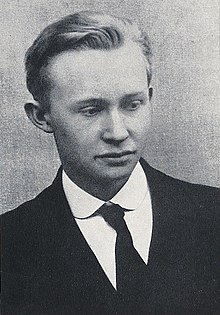Georg Muche
Georg Muche (born May 8, 1895 in Querfurt , † March 26, 1987 in Lindau ) was a German painter , graphic artist and university professor.
Life
During his school days in Querfurt , Muche practiced drawing from school friends, made studies of nature, made copies of the old masters such as Titian , Rembrandt and Rubens in oil paint, and occupied himself with van Gogh and Cézanne .
At the age of 17 Muche left school without a high school diploma to study painting with Anton Ažbe at his private art school in Munich . After only one year of classes and the rejected application at the Bavarian Art Academy , he went to Berlin in 1914 and there came into contact with the group around Herwarth Walden's gallery “Der Sturm”. As early as 1916, together with Max Ernst, he arranged an exhibition with 22 works for the young Muche. Although without any training, he was employed in the art school of the "Sturm", founded in September 1916, because of his outstanding skills as a teacher of painting. Until 1917 there were further "Sturm" exhibitions with Paul Klee and Alexander Archipenko .
In 1918 Muche was drafted into the military and became a pacifist in the turmoil at the end of the First World War . After 1919, he now lived in Berlin, he became a member of the November group , in whose exhibitions he participated from 1927 to 1929. In 1920 he was called to Weimar by Walter Gropius to work as a master of wood carving at the Bauhaus . From 1921 to 1927 he was head of the weaving workshop , gave preliminary courses and headed the committee for the Bauhaus exhibition of 1923 , for which the “Am Horn” model house was designed and built. In 1925/26 he designed the “ Dessau Steel House ” with the help of the architecture student Richard Paulick . In 1922 he married the Bauhaus student Elsa Franke.
In 1927 he moved back to Berlin, where he was a teacher at Johannes Itten's private art school until 1930 . With Itten, whom he had already met in 1916, he shared common philosophical and educational ideas. Up until Itten's departure in 1923, they had already taken the “preliminary course” together at the Bauhaus, but above all they both followed the teachings of Mazdaznan , an Eastern cult based on Zoroastrianism . Between 1931 and 1933 he held a professorship for painting at the State Academy of Arts and Crafts in Breslau .
During the time of National Socialism , Muche taught from 1933 to 1938 at the “ Art and Work ” school in Berlin, which was directed by Hugo Häring , and dealt almost exclusively with fresco painting . In response to a decree by Joseph Goebbels dated June 30, 1937, thirteen of his works were confiscated as “ degenerate art ”, two of which were shown at the exhibition of the same name in Munich that same year.
From 1939 to 1958 Muche headed the newly established “Master Class for Textile Art”, which was administratively affiliated with the Higher Technical School for Textile Industry (from 1944 textile engineering school ) in Krefeld . In 1942 Georg Muche painted large frescoes in Kurt Herberts' paint factory in Wuppertal, which were destroyed in a bombing raid the following year.
In 1960 Muche moved to Lindau / Bodensee , where he worked as a freelance painter, graphic artist and writer and dealt with art theories. The city of Lindau honors him in its city museum ("Cavazzen") with a room named after him with his works. His grave in the Lindau cemetery was abandoned after the rest period in 2007. In 1955 his works were exhibited at Documenta 1 in Kassel . In 1979 he was awarded the Lovis Corinth Prize .
Georg Muche was a member of the Deutscher Künstlerbund and the Deutscher Werkbund .
student
- Werner Schriefers
- Heinz Trokes
- Thyra Hamann-Hartmann
literature
- Ludger Busch: Georg Muche. Documentation on the painting work from 1915 to 1920. A contribution to the discussion on Expressionism. E. Wasmuth, Tübingen 1984.
- Magdalena Droste: Georg Muche . Mann, Berlin 1980, ISBN 3-7861-1301-7
- Bernd Grönwald : Georg Muche and his work in the GDR . In: form + Zweck 8/6, Berlin 1975, pp. 25-27
- Bernd Grönwald: Laudation for Georg Muche , in: Wissenschaftliche Zeitschrift der HAB Weimar 28, Issue 4/5, 1979, pp. 291–294
- Gisela Linder: Georg Muche: the decades at Lake Constance, the late work . Gessler, Friedrichshafen 1983, ISBN 3-922137-20-2
- Gisela Linder: Muche, Georg. In: New German Biography (NDB). Volume 18, Duncker & Humblot, Berlin 1997, ISBN 3-428-00199-0 , p. 252 f. ( Digitized version ).
- Friedegund Weidemann: Georg Muche . State Museums, Berlin 1985
Web links
- Literature by and about Georg Muche in the catalog of the German National Library
- georg-muche.de
- Georg Muche. In: arch INFORM .
- Materials by and about Georg Muche in the documenta archive
- [1] at the Lindau City Museum
Individual evidence
- ^ Stephanie Barron: Degenerate Art. The fate of the avant-garde in Nazi Germany. Los Angeles County Museum. Hirmer, Munich, ISBN 3-7774-5880-5 , p. 305.
- ↑ kuenstlerbund.de: Full members of the German Association of Artists since it was founded in 1903 / Muche, Georg ( Memento of the original from March 4, 2016 in the Internet Archive ) Info: The archive link has been inserted automatically and has not yet been checked. Please check the original and archive link according to the instructions and then remove this notice. (accessed November 19, 2015).
| personal data | |
|---|---|
| SURNAME | Muche, Georg |
| BRIEF DESCRIPTION | German painter, graphic artist, Bauhaus style |
| DATE OF BIRTH | May 8, 1895 |
| PLACE OF BIRTH | Querfurt |
| DATE OF DEATH | March 26, 1987 |
| Place of death | Lindau |
